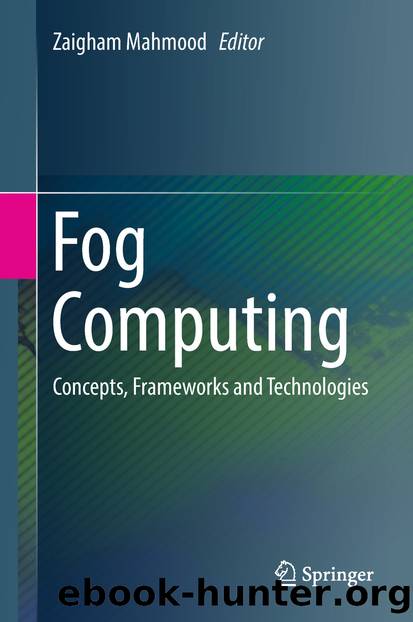Fog Computing by Unknown

Author:Unknown
Language: eng
Format: epub
ISBN: 9783319948904
Publisher: Springer International Publishing
To have a better QoE , FRAN is adapted with four transmission modes such as the following:Device-to-device relay mode
Distributed (local) coordination mode
Centralized (global) mode
Macro Remote Radio Heads (MRRH) mode [8]
The Fog user devices dynamically decide the mode of transmission based on the communication location, the distance between the communicating devices, computing and caching capacities and the Quality of Service (QoS ).
7.5.3 Handover Administration in FRAN
Administering the handover in any mobile communication is the most important but critical technique to guarantee an unfailing network experience. There are broadly two types of devices based on the mobility in mobile communications, viz the high-speed Fran User Equipment (FUE) and the low-mobility Fran User Equipment. High-speed FUEs need to use MRRH mode that has large geo coverage and reliable network, whereas the low-mobility FUEs can use a small-range radio head. Radio link failures and unwanted handovers are always possible in mobile networks due to a small area of access. Fronthaul gets overloaded due to frequent and rapid handovers affecting the whole network communication. So, the access points and radio heads can collaborate with FUEs in the decision-making of the transmission modes.
One of the main characteristics of 5G technology which yields to QoE is its ability to serve heterogeneous and diversified applications using the same communication platform. Due to the heterogeneous nature, there are many kinds of packets travelling in the network each with different traffic requirements, for instance, the vehicular network requires a very minimal latency. Context-aware applications are able to serve the types of traffic requirements. Fog computing is possible in any of the Edge nodes, core Cloud network or in third-party data centres where the local baseband units can become the computing servers. Computations happen in two ways such as communicational ones or the traffic flow ones.
FRAN attempts to take complete advantages of the Cloud computing model, diversified networks and Fog computing capabilities. The four types of Cloud are:a.Global centralized communication and storage Cloud which is the same as of the centralized Cloud
Download
This site does not store any files on its server. We only index and link to content provided by other sites. Please contact the content providers to delete copyright contents if any and email us, we'll remove relevant links or contents immediately.
Kotlin in Action by Dmitry Jemerov(16849)
Grails in Action by Glen Smith Peter Ledbrook(15158)
Sass and Compass in Action by Wynn Netherland Nathan Weizenbaum Chris Eppstein Brandon Mathis(13111)
Azure Containers Explained by Wesley Haakman & Richard Hooper(7498)
Configuring Windows Server Hybrid Advanced Services Exam Ref AZ-801 by Chris Gill(7491)
Running Windows Containers on AWS by Marcio Morales(7043)
Microsoft 365 Identity and Services Exam Guide MS-100 by Aaron Guilmette(5433)
Microsoft Cybersecurity Architect Exam Ref SC-100 by Dwayne Natwick(5270)
Combating Crime on the Dark Web by Nearchos Nearchou(5017)
The Ruby Workshop by Akshat Paul Peter Philips Dániel Szabó and Cheyne Wallace(4700)
Management Strategies for the Cloud Revolution: How Cloud Computing Is Transforming Business and Why You Can't Afford to Be Left Behind by Charles Babcock(4543)
Python for Security and Networking - Third Edition by José Manuel Ortega(4267)
The Age of Surveillance Capitalism by Shoshana Zuboff(4237)
Learn Wireshark by Lisa Bock(4174)
Learn Windows PowerShell in a Month of Lunches by Don Jones(4047)
The Ultimate Docker Container Book by Schenker Gabriel N.;(3917)
Ember.js in Action by Joachim Haagen Skeie(3605)
DevSecOps in Practice with VMware Tanzu by Parth Pandit & Robert Hardt(3605)
Windows Ransomware Detection and Protection by Marius Sandbu(3572)
